The full feature review of the Mactone XX-440 line preamplifier and MH-120 stereo amplifier has now been published at Positive Feedback, and you can read it HERE.
As is my custom, I like to give you a 'review sneak peek' into my soon to be published feature articles for Positive Feedback.
This time the feature article 'sneak peek' is about the Mactone XX-440 line preamplifier and MH-120 stereo amplifier, one of the most engagingly musical preamplifier-amplifier combinations I have ever come across.
The full article will be published at Positive Feedback in the next few weeks, so stay tuned for more!
Enjoy!
Founded in 1964, and for 59 years now, Mactone has continuously manufactured high-fidelity vacuum tube audio components, longer than any other company in Japan.
Steve Mishoe (In Living Stereo) started importing Mactone audio components to North America in late 2018, after visiting the Matsumoto family - who owns and operates Mactone - in Japan.
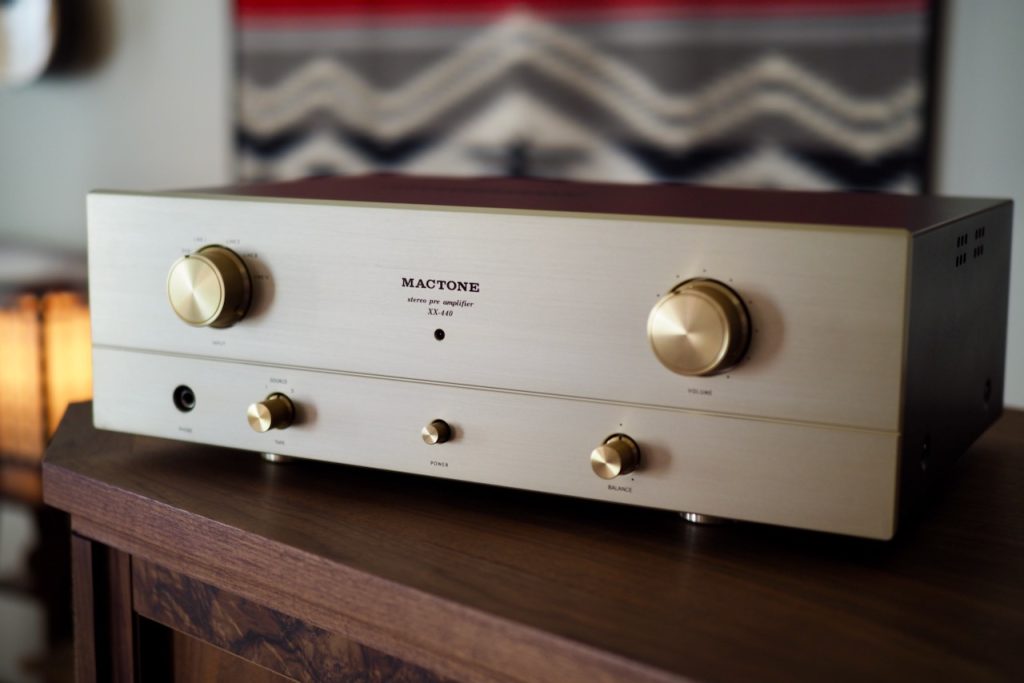
Steve recently contacted me and asked if I’d like to listen to the Mactone XX-440 line preamplifier (photo above) and MH-120 stereo amplifier (photo below), and I of course said, “Yes!”.
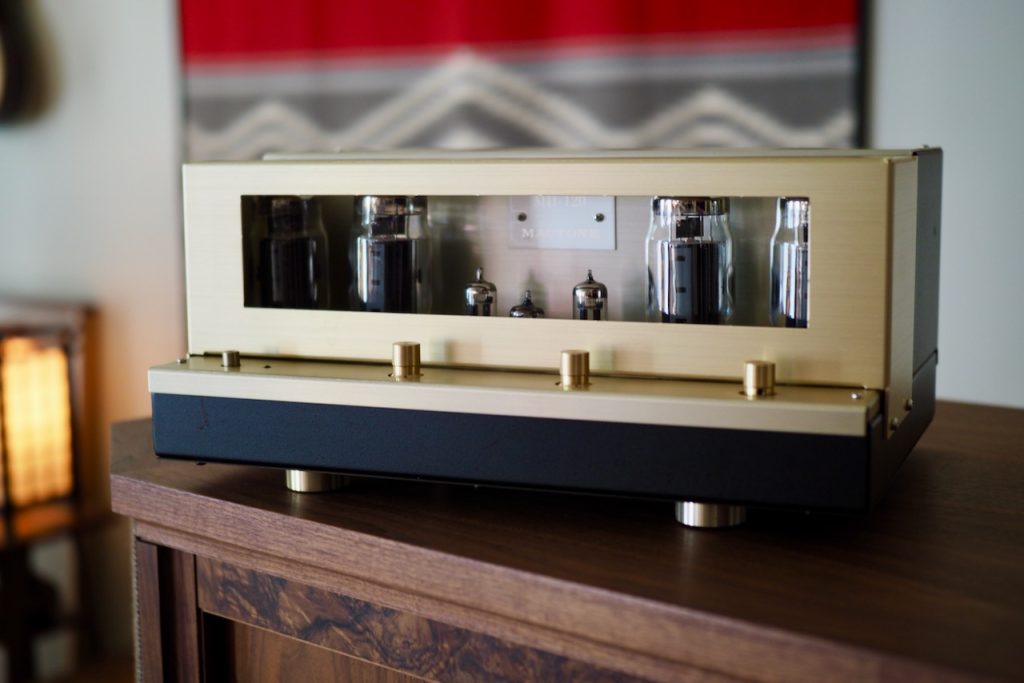
Mactone is a highly revered audio company in Japan, but Mactone isn't as well known to North American audio enthusiasts as some of the other Japanese high-fidelity audio marques, which is rather surprising to me given the level of performance I’ve been hearing from these components.
Steve is trying to heighten that awareness, and get the word out to hi-fi enthusiasts in North America, about what impressive high-fidelity performers these Mactone audio components are.
As an audio writer, its always exciting for me to become aware of a ‘new’ high-fidelity audio company, and have the opportunity to listen to their components with some of my favorite music.
In the case of Mactone, ‘new’ refers only to my limited awareness of the company up to now, as Mactone was founded by Kenjiro Matsumoto in 1964, only a year after the classic McIntosh C22 preamplifier was released, and only two years after the classic Marantz 8B stereo amplifier was released.
Unlike Marantz, which was sold to Superscope in 1964, or McIntosh, which was sold to Clarion in 1990, Mactone has been in continuous production for 59 years with founder Matsumoto-san at the helm.
Mactone's enduring presence as a high-fidelity audio company impresses me. There’s a reason for that endurance, which is the Matsumoto family’s ability to design remarkably musically satisfying audio components, that will bring decades of enjoyment to their owners.
The Matsumoto Family and Mactone
Mactone is a family owned company, founded in 1964 by Kenjiro Matsumoto (center in the photo below), who is now 91 years old, and is still actively engaged in developing Mactone designs. Kenjiro's son Teiichi (left in the photo below), and grandson Daichi (right in the photo below), handle building the equipment, and day to day operations.
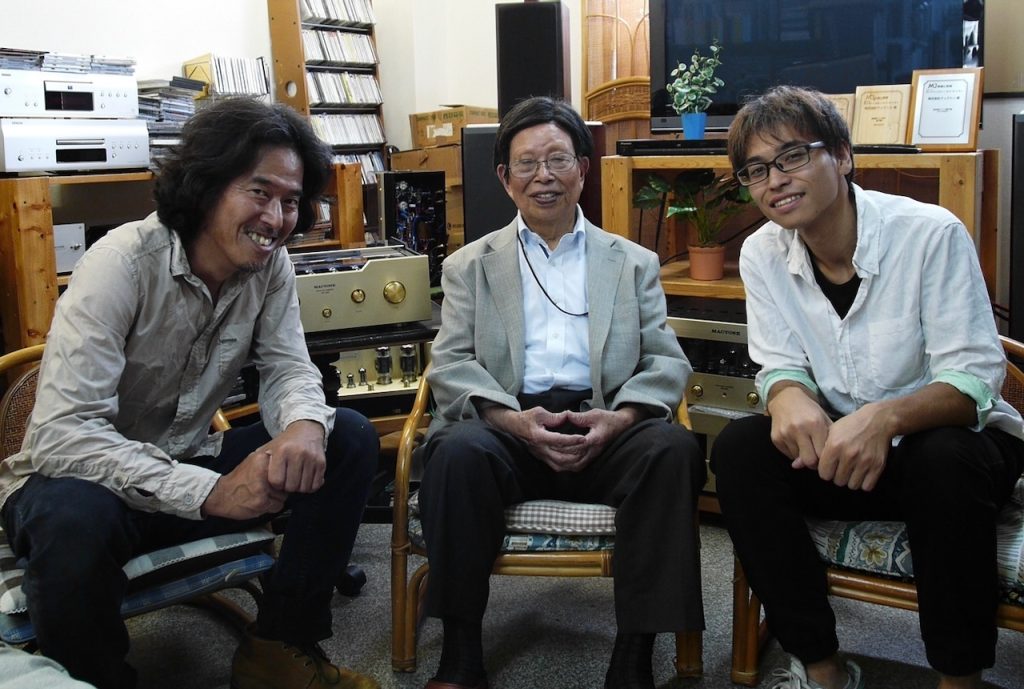
Matsumoto-san passing down the vision and passion for his Mactone high-fidelity audio creations through the family generations, to son and grandson, strikes me as an inspiring and heart warming heritage.
I asked Steve Mishoe if he could tell me a little more about the history of Mactone:
"Born in Tokyo, Kenjiro Matsumoto started in the audio business with his father's support when he opened an electronics retail shop. All the while he was studying electronic engineering, and graduated from Tokyo Denki Daigaku University of Electricity."
"In 1964 Matsumoto-san founded Mactone where he began designing and building his first vacuum tube amplifiers and preamplifiers. Quality transformers were always at the top of his quality list in components, and so he began building and winding his own.”
"To illustrate how long Kenjiro has been at it, one must understand the technology that was available in the mid 1960s. In order to build a properly matched transformer, Kenjiro had to derive the constant of the transformer by calculating the square root. At first, a hand cranked calculator was used to generate real numbers, but this was extremely time consuming. When the first calculators were available, Kenjiro jumped at buying one. It may be hard to believe now, but the first calculator with a square root function cost 200,000 yen (approximately $1500 USD). Kenjiro didn't have the money to buy it outright so he took out a loan and paid it back over 10 months. After getting the calculator, constant calculations became much easier."
"After many years of perfecting his designs, it became difficult for Kenjiro to properly manufacture the equipment, as lifting and soldering tube amplifiers became difficult for a man in his 80s. "My eldest son helps me make amplifiers. The beginning of a new Mactone", said Matsumoto-san.””
"It was Teiichi, his eldest son, who stood up to the task. Teiichi Matsumoto was born in 1963 in Hachioji, Tokyo. Teiichi liked to listen to records with songs such as "Queen of Sheba" and "007's Theme". He also liked listening to overseas shortwave broadcasts and recording FM broadcasts on cassette tapes. He helped with the family business, receiving an allowance for installing parts on chassis and winding transformers.”
"Teiichi-san seemed to have a natural talent for making things. After a three year term, Teiichi retired from the Japanese Self Defense Force. It was the early 90's and he began doing custom mods in a motorcycle shop. All the while he helped his father build Mactone products.”
"In 1999, Teiichi-san opened up a Harley-Davidson motorcycle specialty shop called Black Chrome Bike Works. Teiichi loves his Harley-Davidsons dearly, in particular, the 45 degree narrow angle V-twin engines odd beat-like rumble. Teiichi-san still owns Black Chrome Bike Works, and between him and his son Daichi, they manage both the motorcycle and audio businesses.”
"Since rejoining Mactone, Teiichi's perfectionistic ways have helped the current Mactone offerings to be better built both inside and out. Teiichi is in charge of building all export products. Once Teiichi inherits the responsibilities of running Mactone, he says, "There is no need to chase a new format like Harley does. It is important not to change Mactone's uniqueness and design philosophy.”
The Mactone Design Philosophy
"We believe that it is impossible to create an amplification system that produces sound closest to a live performance without a vacuum tube based circuit. A properly designed tube based circuit allows for hours of fatigue free listening. In order to realize good sound, Mactone has designed unique proprietary circuitry that pushes the envelope of performance for vacuum tubes. Our tube amplifiers and single-stage preamplifiers, are assembled and adjusted by hand without using cheaper printed circuit boards."
"Mactone has always focused on improving sound quality with research and development, and has developed its own circuit configuration. Also, when designing output transformers, including power transformers, we clarify the interrelationship between the circuit and the output tube, and determine the optimal winding method and core quality that improves sound quality. Moreover, all circuits are point to point wired by hand. In addition, third-order distortion, which adversely affects the tone, is extremely low in vacuum tube circuits compared to semiconductor designs."
"We believe that negative feedback in tube preamplifiers negatively affects performance. Mactone preamplifiers are non-feedback designs."
"Kenjiro and Teiichi are currently working on developing a power amplifier design utilizing 300B vacuum tubes in a parallel push-pull configuration. Teiichi is excited about the current Mactone and sees a long and bright future for company.”
The Mactone XX-440 Line Preamplifier ($11,500 USD) and MH-120 Stereo Amplifier ($13,500 USD)
The Mactone XX-440 line preamplifier is nicely constructed with a high level of build quality that is comparable to other premium high-fidelity marques.
The faceplate is finished in an attractive gold finish that gives the XX-440 an elegant and refined appearance.
The bottom of the chassis is supported by four high-quality footers.
Let’s do a ‘walk around’ of the Mactone XX-440 line preamplifier and explore its features.

On the front of the Mactone XX-440 line preamplifier, we see the input selector knob on the top left, with input selections for six sources: CD, DVD, Line I, Line II, Line III, and Line IV.
Below and to the left of the input selector knob is the headphone output. The headphone output is driven directly from the preamplifier circuit.
To the right of the headphone input is a tape source selector switch, which allows for selection between two tape decks, say a cassette deck, or a reel to reel, for example.
At the bottom middle of the front panel is the power on-off switch. Let me add a “Hooray!” for the sensible location of the front panel power switch, which makes it easy to turn the XX-440 on and off when placed in an equipment rack.
To the right of the power switch is the balance control, and in the upper right of the front panel is the volume control.
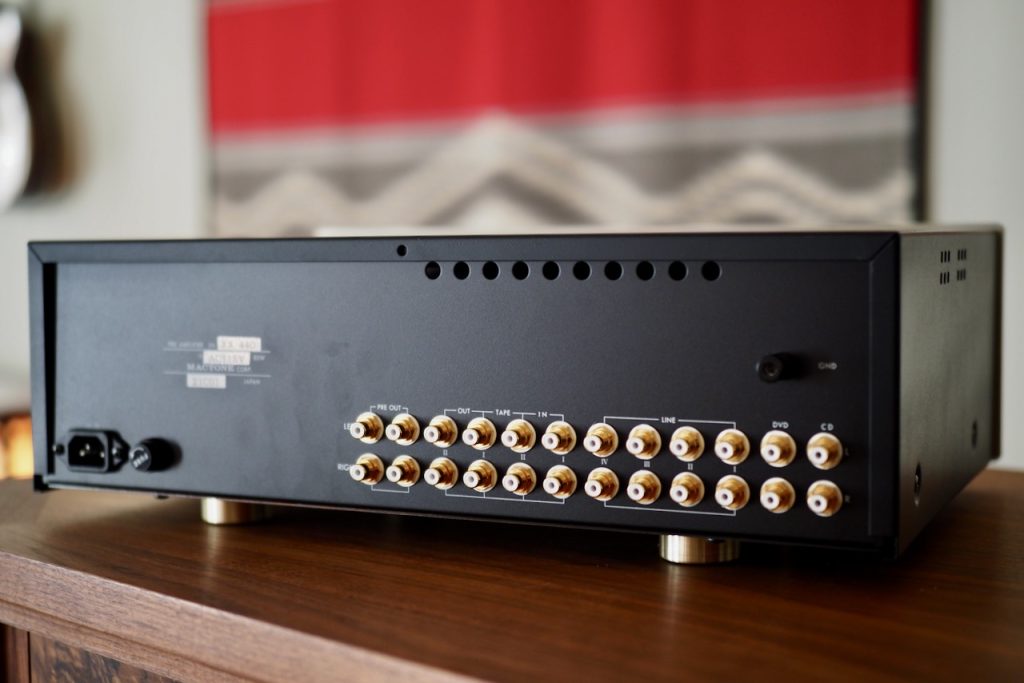
Around back of the Mactone XX-440 line preamplifier, starting on the left side, we see a dedicated IEC power cord connector, which makes it easy to pair the XX-440 with a larger diameter high-quality power connector like those from Furutech, for which I award another “Hooray!” to Mactone.
To the right of the IEC connector is the fuse holder.
Towards the middle of the back panel are two pairs of RCA preamplifier output connectors. Two pairs of RCA connectors allows for a bi-amp arrangement for two amplifiers, or alternatively, one pair of connectors could be used for a stereo amplifier or a pair of monaural amplifiers, and the extra pair of RCA outputs could be used to connect a dedicated headphone amp to the system for those with particularly difficult to drive headphones.
To the right of the pre out RCAs are four pairs of tape in-out RCAs for connecting two tape recorders.
To the right of the tape in-out RCAs are four pairs of RCA inputs for connecting line-level sources such as phono stage, an FM tuner, a reel to reel, etc.
To the right of the of the four pairs of RCA inputs is a pair of RCA inputs for connecting a DVD player, and directly above the DVD input is a grounding post. To the right of the DVD player inputs is a pair of RCA inputs for connecting a CD player. Both the DVD and CD inputs are electrically the same as the other line level inputs, so if you don’t have CD or DVD sources to connect, you can connect any other line level source you wish.
That’s it for exploring the external features of the XX-440, now let’s take a look inside the Mactone XX-440.
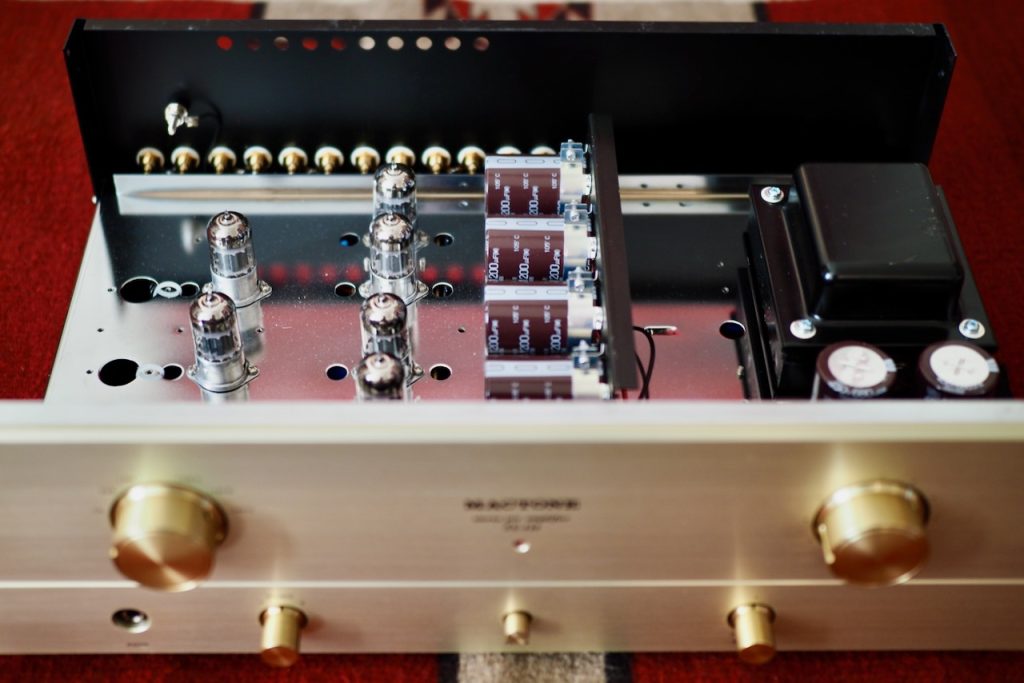
The XX-440 preamplifier, like all Mactone products, is completely point to point wired. The main goal for all the Mactone preamplifiers is to lower output impedance and increase bandwidth via a single-ended push-pull circuit (SEPP).
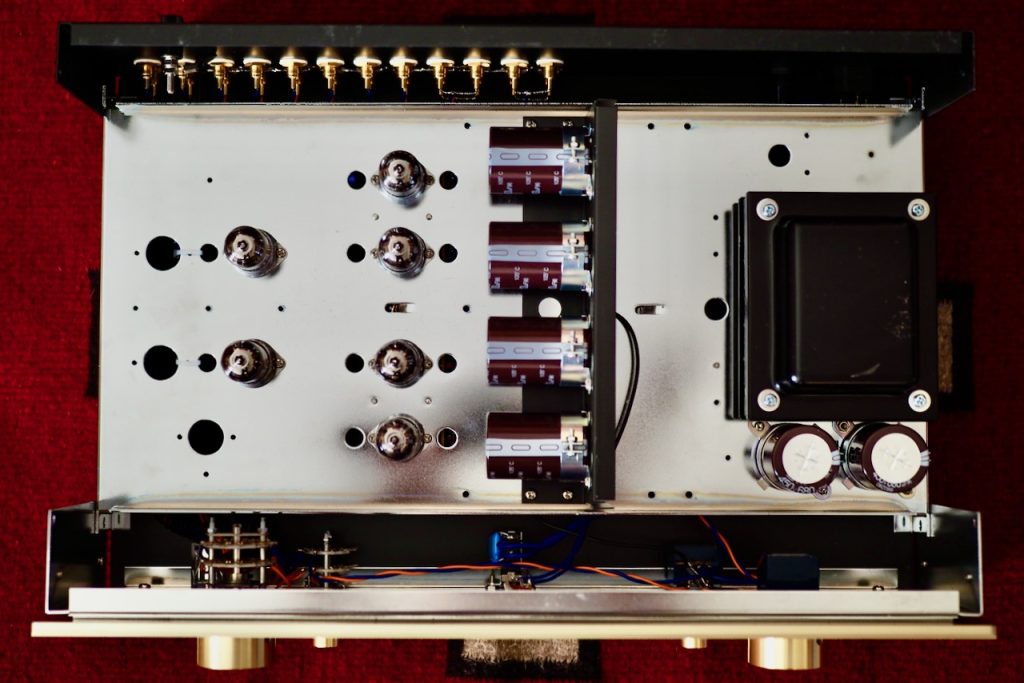
The XX-440 is an output transformerless design (OTL). The output is divided into two levels with 12AU7 tubes operating in parallel, so the overall circuit consists of 4 parallels and a total of 4 SEPP circuits. An intriguing design.
Since the XX-440 utilizes a positive and negative one-sided power supply (right side in the photo above), the output goes through a capacitor. The initial stage is cathode coupling and phase inverting via the 12AU7. Loop negative feedback is not applied, and the power supply uses a choke.
The Mactone XX-440 is thoughtfully designed, with an abundance of user-friendly features, utilizes high-performance amplification circuitry, point-to-point wiring, and a robust build quality.
Visitors to my listening room have complimented the attractive and elegant appearance of the gold-toned finish of the Mactone XX-440 line preamplifier and MH-120 stereo amplifier.
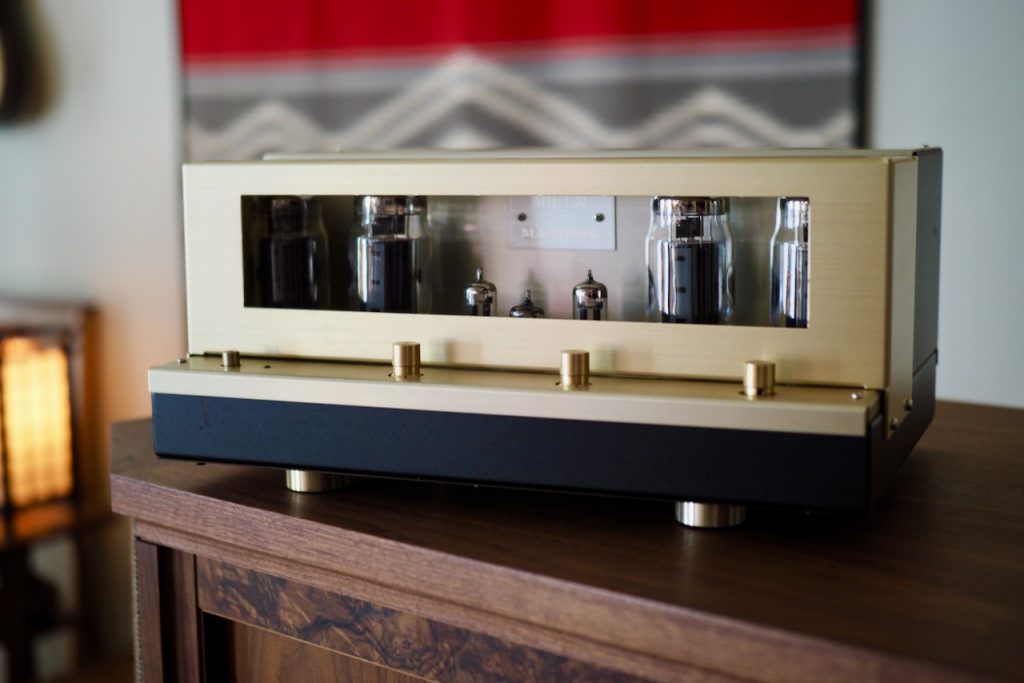
Now lets do a ‘walk around’ of the Mactone MH-120 stereo power amplifier.
First of all, the finish of the MH-120 stereo amplifier matches that of the XX-440 preamplifier, with attractive gold-toned top covers, which are contrasted and complimented by the matte black finished chassis. On the bottom of the chassis there are four high-quality footers.
There is a matching tube cage provided to minimize potential contact with the hot vacuum tubes, and I like the way the tube cage looks when in place. Steve Mishoe told me he thinks the MH-120 sounds better with the tube cage removed, so that’s how I listened to it for this review.
As with all vacuum tube amplifiers, you’ll want to make sure to keep curious spouses, friends, pets, and children from touching the hot exposed tubes.
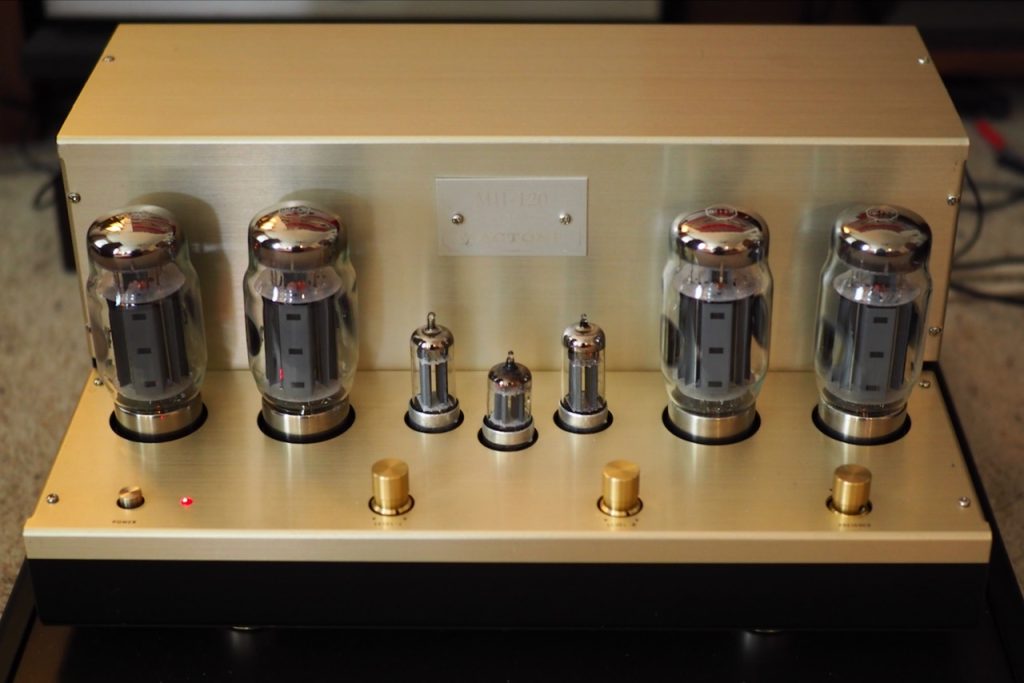
On the left of the chassis is the power on-off switch (with a red power-on indicator light next to it), which earns Mactone another “Hooray!” from me for locating the power on-off switch on the front of the chassis for an easily accessible location when installed in an equipment rack.
In the center front of the chassis are separate level controls for the right and left channels.
On the right side of the chassis is a three position “presence adjustment knob” that allows the listener to optimize the MH-120’s performance for room traits, or for variations in recording quality of albums.
The left setting is flat and offers the most detail, the middle setting has slightly less bass for more excitable rooms or recordings with too much bass, and the third setting has an attenuated treble for brighter rooms or recordings with too much treble.
You might be tempted to think of the presence adjustment knob as a simple potentiometer based tone control, but its not. Rather, the presence knob works by varying the amount of negative feedback. The left setting has the least amount of negative feedback at 2 dB, the middle position has 4 dB of negative feedback, and the right position has 4 db of negative feedback at 50 Hz.
I really like Mactone's inclusion of the presence adjustment knob on the MH-120 amp, I wish every manufacturer offered that kind of feature, and so I award Mactone another “Hooray!”. Well done Mactone!
Recordings can vary all over the place in how well they are balanced across the bands that make up the audio spectrum. What I've found is that the MH-120 amp's presence knob works really well for bringing sound quality back into balance when things are a little out of whack in a recording, which I’ll discuss with some examples in the listening portion of this article.
For example, if the presence or brilliance bands of recordings are goosed up too much during mastering, like they are in some albums marketed to audiophiles, setting the MH-120 amp's presence knob to the right setting that attenuates treble slightly helps calm down those albums.
When the bass region has been boosted too much during mastering it makes the bass sound boomy, and the middle setting of the presence knob corrects for too much bass boost in a recording.
For well sorted recordings, the left setting of the presence knob provides for a flat response and provides the most detail from the recordings.
Note: The Teach Me Audio website has an excellent discussion of how varying the boost of each of the seven frequency bands of the audio spectrum in a recording during mastering can change the overall sound of the recorded music. It’s worth reading, and helps one understand better what you are hearing from different albums played back through your audio system, and why the inclusion of the presence adjustment feature in the MH-120 amp is such a great idea.

The vacuum tubes you see, left to right, are a pair of Tung-Sol KT120 beam pentode power tubes for the left channel, an Electro-Harmonix 12BH7 twin triode driver tube for the left channel, a NOS JAN GE 6189W twin triode input tube (12AU7WA / ECC82 equivalent), another Electro-Harmonix 12BH7 twin triode driver tube for the right channel, and a pair of Tung-Sol KT120 beam pentode power tubes for the right channel.
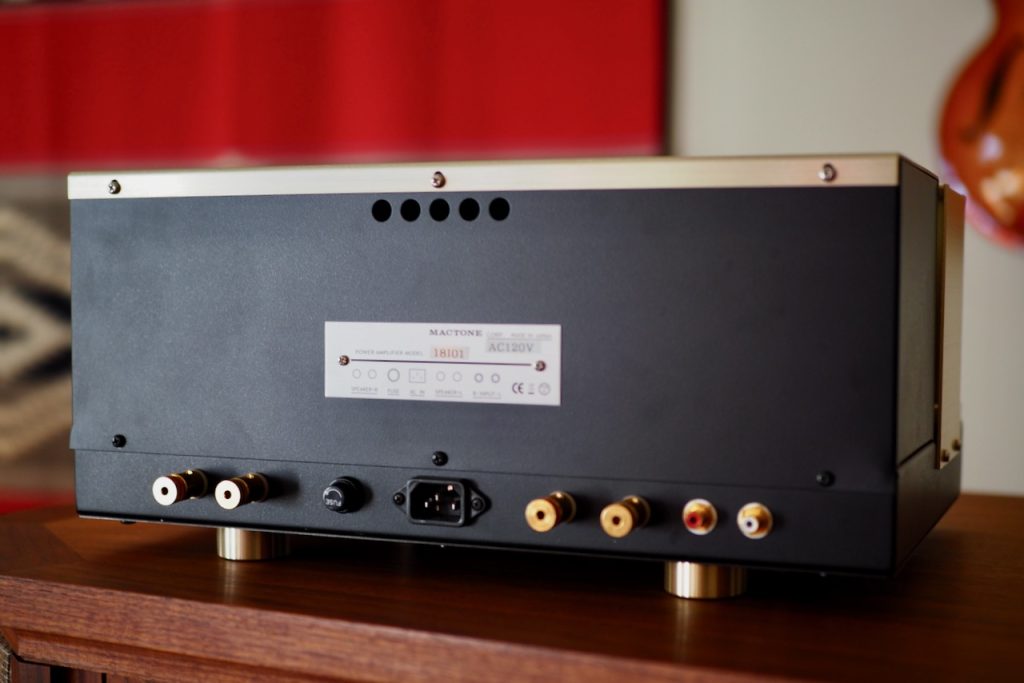
Around back of the MH-120, left to right, are a pair of binding posts for the right channel, a fuse holder, an IEC connector, a pair of binding posts for the left channel, and a pair of RCA inputs for connecting a preamplifier.
Design-wise, the MH-120 utilizes a pair of Tung-Sol KT120s in each channel, in a self-biasing, low negative-feedback, push-pull, Class AB circuit to deliver 65 watts of output power per channel.
Mactone chose the KT120 over the other tubes in the 6550/KT88/KT90 family for its higher power output, increased ruggedness and long life, and superior dynamic and tonal qualities.
Tung-Sol describes the KT120 (specs HERE) as a robust and long-life vacuum tube rated for designs of up to 200W per channel, and “… the KT120 is impervious to overload, delivering peak power with extreme reliability and almost infinite tube life.”
The KT120s in the MH120 ought to last a good long time with their easy load and comparatively modest power output.
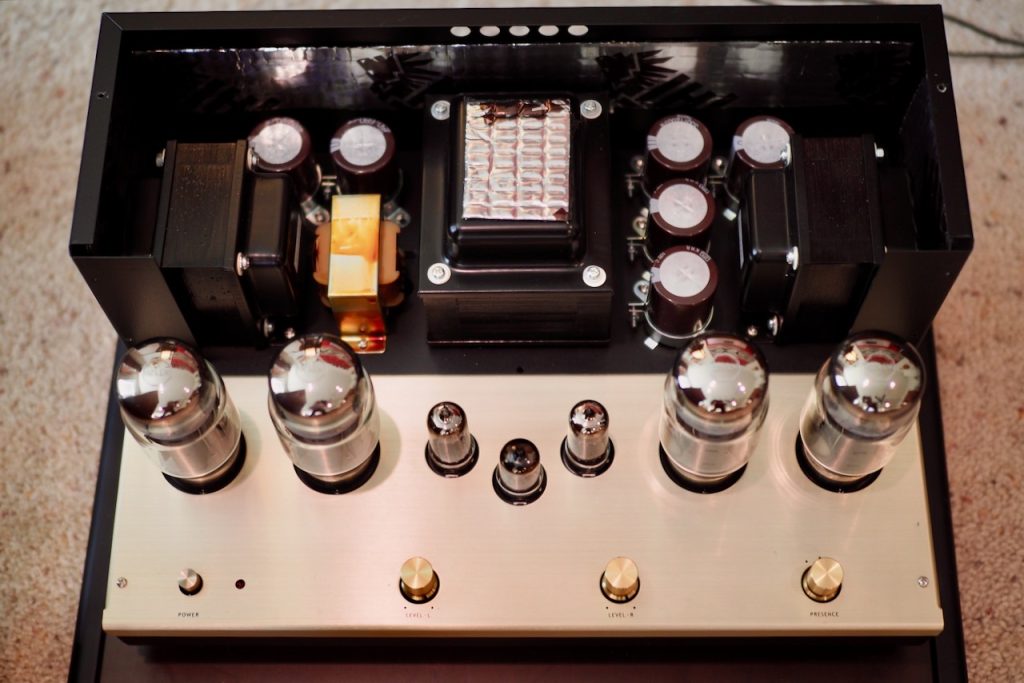
Mactone winds its own transformers for the MH120 amp to achieve the performance level they desire, and the transformers are of the "orient core" variety, which orients the grain of the silicon steel for better performance.
The small ‘transformer’ you see in the above photo is not a transformer, but rather a choke, that is placed in the high-voltage supply and filters out any residual hum/noise in the power supply.
In the photo below you can see the elegant point-to-point wiring used by Mactone.
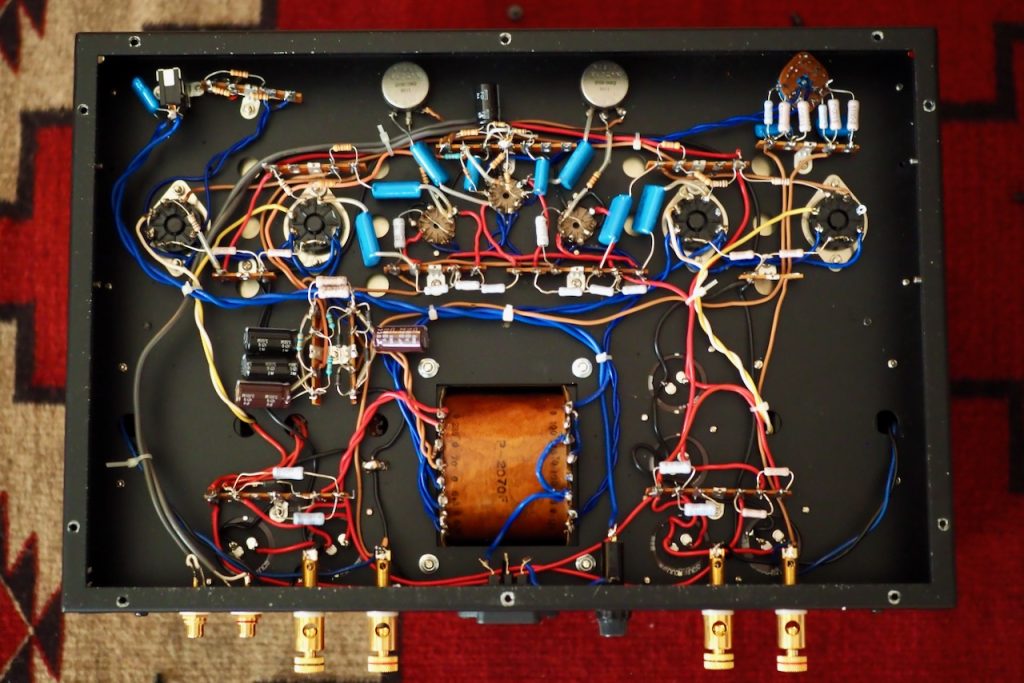
The Mactone MH-120 is an attractively finished stereo amplifier, that has a high quality of build level, a number of thoughtful user features, like the presence adjustment knob, the left and right channel level controls, and a power on-off switch located on the front of the chassis.
Audio System for this Review
For this article I used my usual Tannoy Westminster Royal SE loudspeakers that have been hot-rodded with an internal rewire using vintage Western Electric WE16GA tinned-copper wire, and custom external Duelund crossovers utilize pure silver Duelund CAST components in the high-frequency / midrange circuit, and Duelund CAST pure copper components for the rest, with Duelund DCA16GA tinned-copper wire connecting everything together.
The Mactone MH120 stereo amplifier was connected directly to the external Duelund crossovers with Duelund DCA16GA tinned-copper speaker cables.
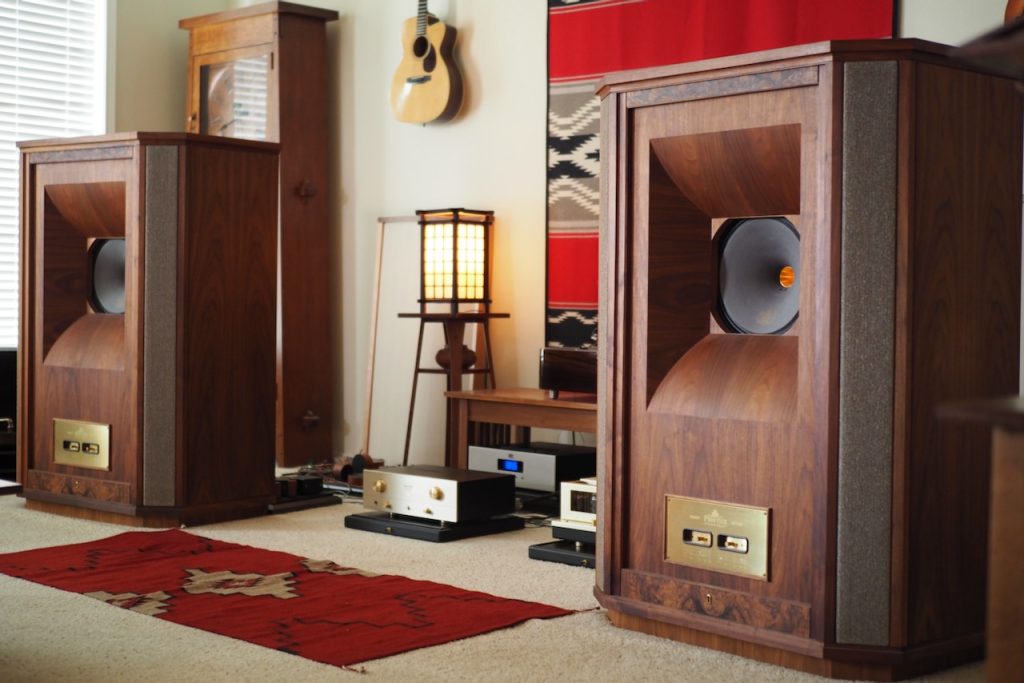
The Mactone XX-440 preamplifier was connected to the MH120 power amplifier with Duelund DCA16GA tinned-copper interconnects.
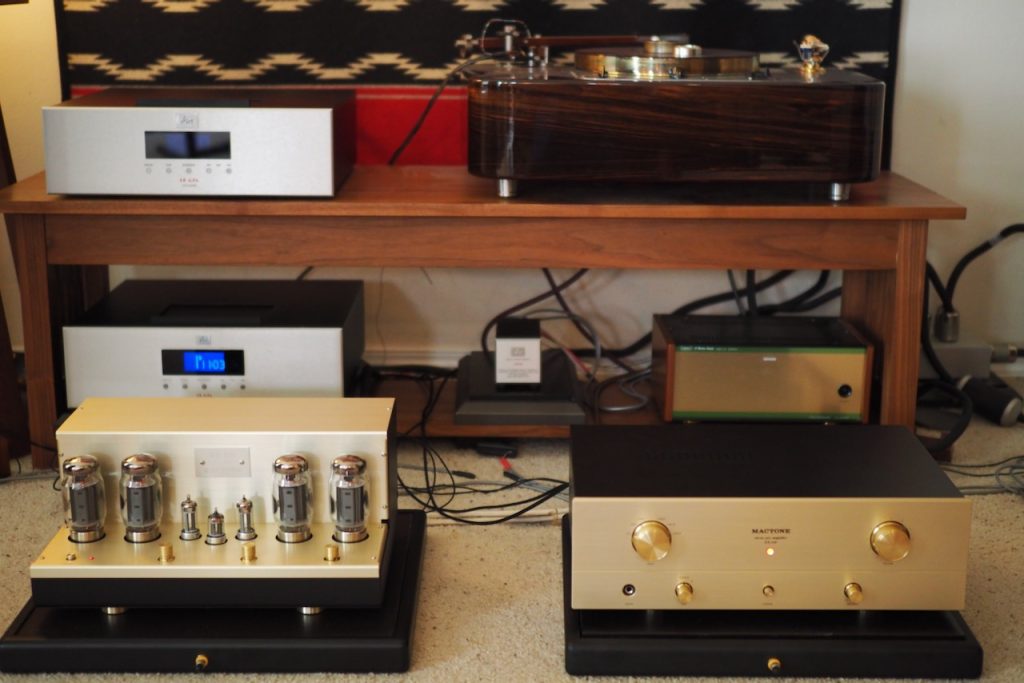
The Audio Note (UK) CD 5.1x CD player ($30,850 USD, in for review) was used as the source, and was connected to the XX-440 preamplifier with Belden 8402 microphone cable interconnects.
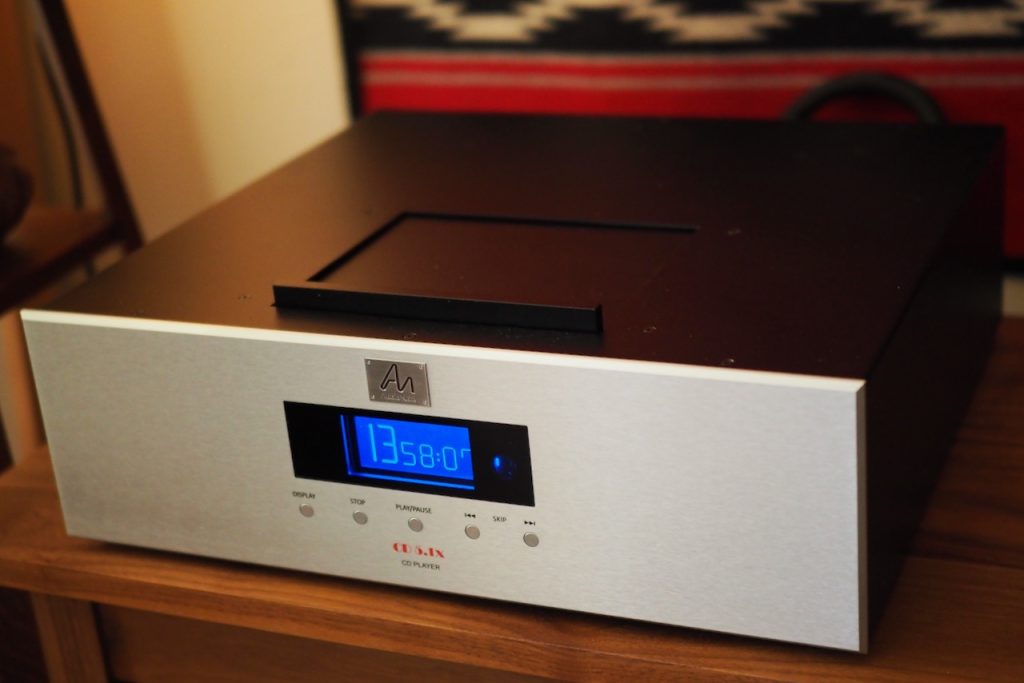
The wall AC outlets consisted of Acoustic Revive CB-1DB receptacle base plates, CFRP-1F carbon fiber outlet plates, and custom modified Acoustic Revive modified Oyaide R-1 receptacles. AC from the outlet to the Acoustic Revive RPT-6 Absolute NCF Power Distributor was via an Acoustic Revive Absolute power cable, and power cables to components were a mix of Acoustic Revive Power Reference TripleC NCF AC power cables (amplification components), and Acoustic Revive Absolute power cables (source components).
Listening Impressions
Ok, that's it for now. Expect the full feature article to be published at Positive Feedback in the next week or two.
As always, thanks for stopping by, and may the tone be with you!



























